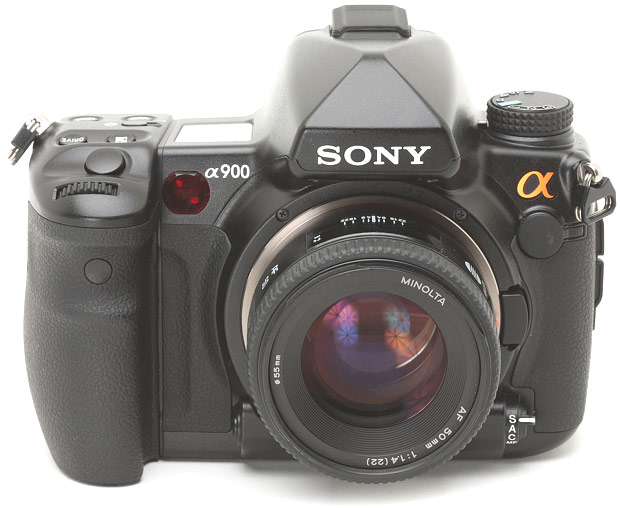Sony Alpha 900: 24 megapixel DSLR
Sony has finally launched the flagship DSLR in its famous “α” (Alpha) camera lineup. Since March 2007, the Sony Alpha 900 has been shown (!) At all photo exhibitions, but only behind glass at exhibition stands. We have even lost hope that it will really go into circulation, it seemed so unreal to make a photo sensor of 35 mm format using CMOS technology (and solve all the related problems) that no one has ever managed before. Still, Sony engineers were able to do it.
/>
In the α900, we see - for the first time - a full-size 35 mm CMOS matrix with a record resolution of 24.6 million effective pixels. This is the world's best sensor in its class, it is made at Sony's Japanese factories. In terms of physical size, such a matrix fully corresponds to the usual frame of a 35 mm format film, that is, 36 x 24 mm. This is really a lot, and taking a picture of the maximum size of 6000x4000 pixels from it and processing it quickly is a really non-trivial task. For this, a special Bionz image processing system with two paths was developed at once (there was only one path in the α700). But even this did not help much, so in the high-speed shooting mode at a maximum resolution, the α900 is not as fast as the 12-megapixel α700, which is not surprising.
In addition to the record resolution, the Sony Alpha 900 became the world's first 35 mm camera with a built-in image stabilization system (SteadyShot Inside). That is, the system on the gyros moves the platform itself with the sensor in directions opposite to the wiggler.
')
Compared to the A700, the camera was improved externally: the case was made of a magnesium alloy and, in general, it is now more comfortable. Professional photographers will surely be pleased with the new, large and bright viewfinder, which covers 100% of the frame area (in the α700 only 95% covered). The picture in it is fully consistent with the resulting image. As you know, professionals do not use when viewing LCD screens due to numerous distortions both in terms of frame size and color reproduction, not to mention other shortcomings of electronic screens.
In general, the camera turned out to be much more powerful and in almost all respects better than the α700. It is insulting that it has become even more overall (as seen in the picture below) and a quarter heavier than its predecessor: together with the α900 battery weighs 900 g, and if you add another good lens here, the weight will increase one and a half times.

/>

In the α900, we see - for the first time - a full-size 35 mm CMOS matrix with a record resolution of 24.6 million effective pixels. This is the world's best sensor in its class, it is made at Sony's Japanese factories. In terms of physical size, such a matrix fully corresponds to the usual frame of a 35 mm format film, that is, 36 x 24 mm. This is really a lot, and taking a picture of the maximum size of 6000x4000 pixels from it and processing it quickly is a really non-trivial task. For this, a special Bionz image processing system with two paths was developed at once (there was only one path in the α700). But even this did not help much, so in the high-speed shooting mode at a maximum resolution, the α900 is not as fast as the 12-megapixel α700, which is not surprising.
In addition to the record resolution, the Sony Alpha 900 became the world's first 35 mm camera with a built-in image stabilization system (SteadyShot Inside). That is, the system on the gyros moves the platform itself with the sensor in directions opposite to the wiggler.
')
Compared to the A700, the camera was improved externally: the case was made of a magnesium alloy and, in general, it is now more comfortable. Professional photographers will surely be pleased with the new, large and bright viewfinder, which covers 100% of the frame area (in the α700 only 95% covered). The picture in it is fully consistent with the resulting image. As you know, professionals do not use when viewing LCD screens due to numerous distortions both in terms of frame size and color reproduction, not to mention other shortcomings of electronic screens.
In general, the camera turned out to be much more powerful and in almost all respects better than the α700. It is insulting that it has become even more overall (as seen in the picture below) and a quarter heavier than its predecessor: together with the α900 battery weighs 900 g, and if you add another good lens here, the weight will increase one and a half times.

Source: https://habr.com/ru/post/39562/
All Articles